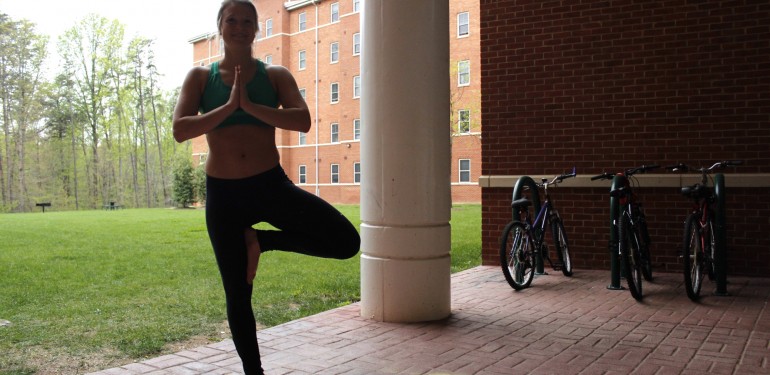Written by Fourth Estate Lifestyle Reporter Raquel DeSouza
At Mason’s Recreational Athletic Complex, there are various yoga classes offered for students and non-Mason students. These classes include Prana Flow, Morning Flow, Vinyasa Flow, Dynamic Yoga for All, Yoga for the Active, Yoga for Runners, Vinyasa Yoga, Yoga Fundamentals, Yoga for the Core and Yoga for Well-Being.
In the United States alone, 20.4 million people do yoga. People join in on the yoga trend for various reasons. Practicing yoga can help with greater flexibility and muscle tone, fat loss and lower blood pressure and give more energy.
Cristina Iturbe, a junior Psychology major, said that she took up yoga because traditional forms of exercise weren’t a possibility for her.
“Yoga seemed new and different. I have knee issues and back issues, and I can’t do running. Yoga works you out, but I don’t feel that pain. So it’s something that I can do to help keep me in shape and not hurt myself,” Iturbe said.
Junior Communication major, Alison Peterson, goes to yoga about three to four times a week. She said that the benefits from doing yoga are more than just greater physical fitness.
“To me, practicing yoga is a type of exercise that connects your mind and body,” Peterson said. “It has helped me become more aware of myself physically, emotionally and mentally.”
Some of the mental benefits of yoga are less stress, better concentration and better memory, which are all necessary for a busy college student.
But not every active and fit person at Mason decides to incorporate yoga into his or her regular workout routine.
Aaron Coffin, junior Conflict Analysis and Resolution major, actively works out four days a week for cardio and does weight training twice a week as well. Since he’s been working out, he has taken Bikram yoga, also known as hot yoga, once and has also tried out two other yoga classes.
Coffin said, “It is hard. A lot of people think it’s just a bunch of people getting around, stretching and laying around all day. But it’s actually a strength-based and balanced-based exercise program. It’s amazing. It takes a lot of dedication and repetition; it’s a discipline.”
Coffin said that difficulty and price are two primary reasons he does not regularly practice yoga.
“It’s hard,” Coffin said, “and I also haven’t found a class that I can afford and fits my schedule.”
A Mason student can pay eight dollars for a drop-in class or $50 for one semester, which covers unlimited classes. For non-students, the cost is $70 per semester.
For some yogis, or people who practice yoga, another motive to start this practice is for spiritual connection. Kelley Jones teaches Vinyasa Yoga at the RAC. Her yoga experience began 15 years ago and she has been teaching for almost two years. Her favorite part of doing yoga is the spirituality behind it.
“My personal favorite thing about it is actually not all the poses. It’s actually the philosophical part of it, which you don’t get much into in class,” Jones said.
It is up to the teacher’s discretion on how much philosophical meaning to teach in their classes. Kelley explained that location factors heavily in this decision.
“In a gym, I would put in a little bit. Some gyms don’t allow any of that kind of stuff, so some gyms don’t let you do “oms” or any kind of chanting or anything like that. Here, they’re open to that kind of stuff, so we’re fortunate,” Jones said.
If a Mason student is curious in starting up yoga, the RAC is offering free classes from April 28-May 3. For further information, visit http://fitness.gmu.edu.
(Photo by Amy Rose)




